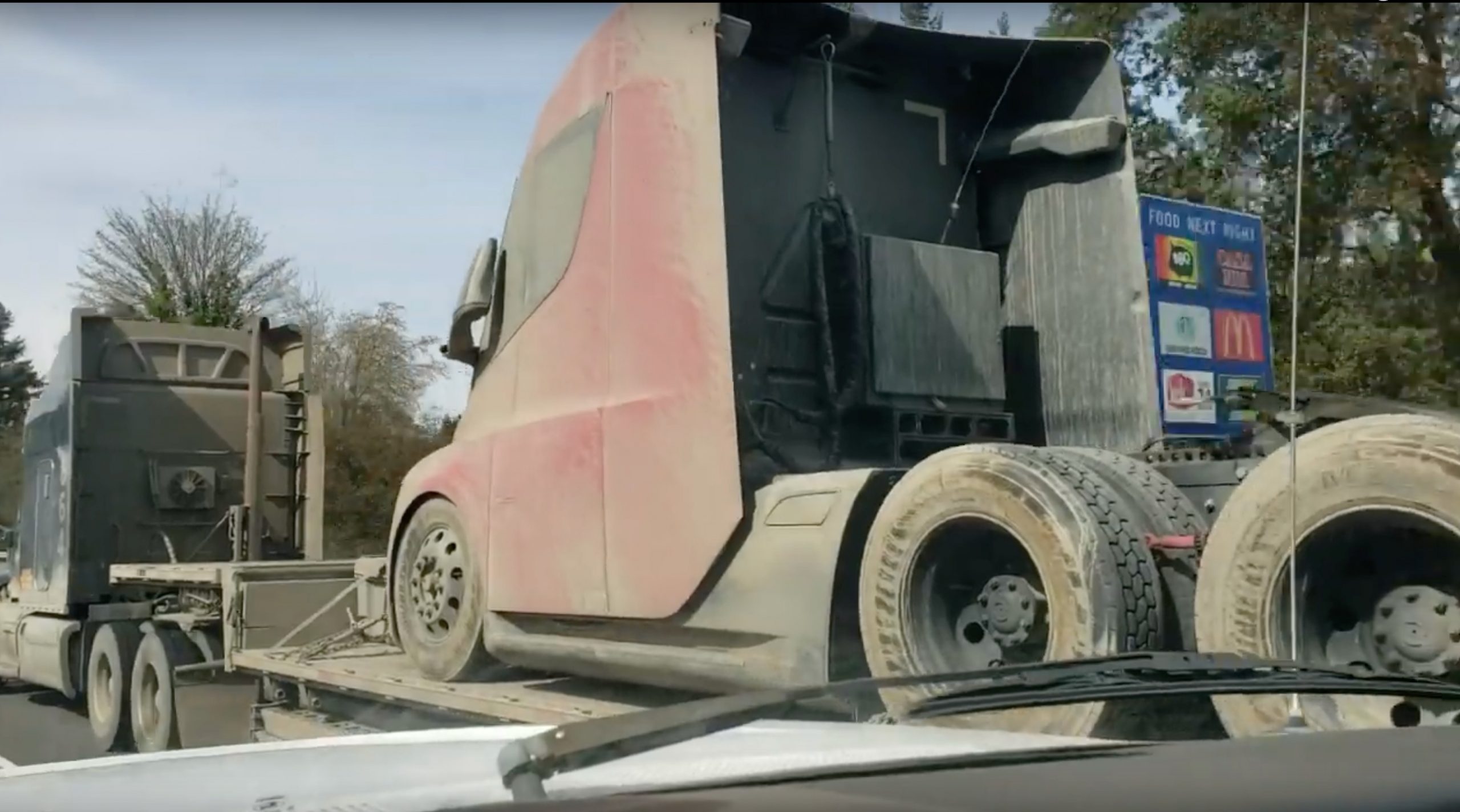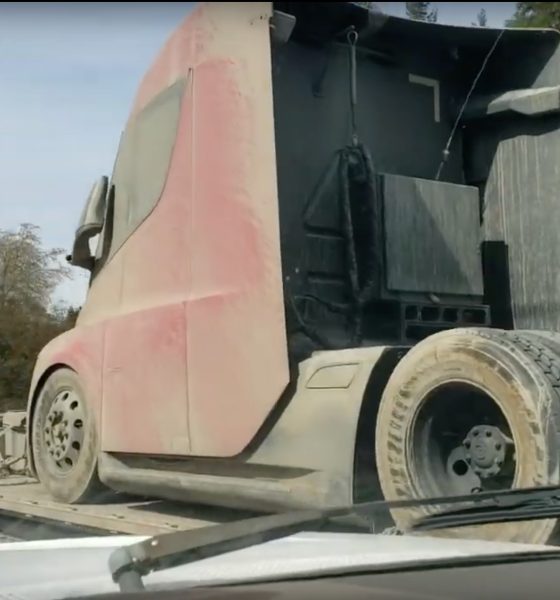A Tesla Semi prototype was spotted in transport, presumably, after having completed several weeks of winter testing near its cold-weather testing facility outside of Delta Junction, Alaska.
Various sightings of the Tesla Semi from over the weekend suggest that the all-electric semi-truck was making its way down the western seaboard of the United States from Washington, through Oregon, and back to its Fremont, California test facility.
Video captures of a Tesla Semi being transported on the back of a semi-trailer shows the prototype’s salt-covered exterior as it makes its way back from cold-climate performance testing under snowy conditions.
Tesla Semi have done some #SosialDistancing @elonmusk hardcore testing? pic.twitter.com/keqweQ6GSh
— John D. (@Real_John_D) March 23, 2020
In January, Tesla noted in an email communication to Semi-truck reservation holders that the truck was undergoing hazard testing at its test facility in Fremont, California.
“Over the last few months, we have continued testing the trucks in real world conditions. We also spent time at a proving ground to evaluate the truck’s resilience over rougher road conditions. Using instruments mounted on the vehicle, we collected road input data to ensure the trucks can handle severely degraded roads. At our own Fremont test facility, we subjected the trucks to a number of high energy, discreet events such as curb strikes, pot holes, and other harsh inputs to confirm the truck is capable of handling common hazards.”
In the same communication, the company indicated that Tesla Semi has already completed “important engineering development checkpoints” and would be rolling out more “production-representative vehicles” vehicles in 2021.
Ahead of planned production, Tesla Semi would undergo several weeks of winter testing. The company has an extreme cold testing facility in Alaska where its vehicles, including the Tesla Model S and Model 3, undergo intense winter testing.
“In the short term, the team is gearing up for several weeks of winter testing to validate the truck’s performance in cold weather and low traction conditions. We are excited to share insights from the winter with you, as we will be able to highlight the major advantages of electric traction and motor control, which no diesel powertrain can match,” said the company in an email to a Tesla Semi reservation holder.
Actually I re-read the letter it says they will have limited volume production 2nd qtr of 2020. pic.twitter.com/A2hTYyTVdz
— chris (@chris31402370) January 9, 2020
Tesla has not confirmed where Semi-truck production will take place, only noting in its fourth-quarter earnings update letter that the facility would be in North America.
CEO Elon Musk indicated in the Q4 earnings call that Tesla Semi would be initially produced in limited quantity as the company focused efforts on increasing battery production capacity. Given the size of the all-electric truck and its energy needs, having a strong supply of battery cells is crucial to preventing a strain on supply for its consumer vehicles like the Model 3 and Model Y.
“So, the thing we’re going to be really focused on is increasing battery production capacity because that’s very fundamental because if you don’t improve battery production capacity, then you end up just shifting unit volume from one product to another and you haven’t actually produced more electric vehicles,” said Musk when asked about the Tesla Semi. “So, that’s part of the reason why we have not, for example, really accelerated production of the Tesla Semi because it does use a lot of cells and unless we’ve got a lot of battery cells available, then — and say like accelerating production of the Tesla Semi would then necessarily mean making pure Model 3 or Model Y cars. And so, we’ve got a really — make sure we get a very steep ramp in battery production and continue to improve the cost per kilowatt-hour of the batteries.”
A Tesla Semi was captured on Sunday, making its way down Interstate 5 in Olympia Washington, roughly 60 miles south of Seattle. Credit: Tvlog.

News
Tesla (TSLA) receives “Buy” rating and $551 PT from Canaccord Genuity
He also maintained a “Buy” rating for TSLA stock over the company’s improving long-term outlook, which is driven by autonomy and robotics.

Canaccord Genuity analyst George Gianarikas raised his Tesla (NASDAQ:TSLA) price target from $482 to $551. He also maintained a “Buy” rating for TSLA stock over the company’s improving long-term outlook, which is driven by autonomy and robotics.
The analyst’s updated note
Gianarikas lowered his 4Q25 delivery estimates but pointed to several positive factors in the Tesla story. He noted that EV adoption in emerging markets is gaining pace, and progress in FSD and the Robotaxi rollout in 2026 represent major upside drivers. Further progress in the Optimus program next year could also add more momentum for the electric vehicle maker.
“Overall, yes, 4Q25 delivery expectations are being revised lower. However, the reset in the US EV market is laying the groundwork for a more durable and attractive long-term demand environment.
“At the same time, EV penetration in emerging markets is accelerating, reinforcing Tesla’s potential multi‑year growth runway beyond the US. Global progress in FSD and the anticipated rollout of a larger robotaxi fleet in 2026 are increasingly important components of the Tesla equity story and could provide sentiment tailwinds,” the analyst wrote.
Tesla’s busy 2026
The upcoming year would be a busy one for Tesla, considering the company’s plans and targets. The autonomous two-seat Cybercab has been confirmed to start production sometime in Q2 2026, as per Elon Musk during the 2025 Annual Shareholder Meeting.
Apart from this, Tesla is also expected to unveil the next-generation Roadster on April 1, 2026. Tesla is also expected to start high-volume production of the Tesla Semi in Nevada next year.
Apart from vehicle launches, Tesla has expressed its intentions to significantly ramp the rollout of FSD to several regions worldwide, such as Europe. Plans are also underway to launch more Robotaxi networks in several more key areas across the United States.
News
Waymo sues Santa Monica over order to halt overnight charging sessions
In its complaint, Waymo argued that its self-driving cars’ operations do not constitute a public nuisance, and compliance with the city’s order would cause the company irreparable harm.

Waymo has filed a lawsuit against the City of Santa Monica in Los Angeles County Superior Court, seeking to block an order that requires the company to cease overnight charging at two facilities.
In its complaint, Waymo argued that its self-driving cars’ operations do not constitute a public nuisance, and compliance with the city’s order would cause the company irreparable harm.
Nuisance claims
As noted in a report from the Los Angeles Times, Waymo’s two charging sites at Euclid Street and Broadway have operated for about a year, supporting the company’s growing fleet with round-the-clock activity. Unfortunately, this has also resulted in residents in the area reportedly being unable to sleep due to incessant beeping from self-driving taxis that are moving in and out of the charging stations around the clock.
Frustrated residents have protested against the Waymos by blocking the vehicles’ paths, placing cones, and “stacking” cars to create backups. This has also resulted in multiple calls to the police.
Last month, the city issued an order to Waymo and its charging partner, Voltera, to cease overnight operations at the charging locations, stating that the self-driving vehicles’ activities at night were a public nuisance. A December 15 meeting yielded no agreement on mitigations like software rerouting. Waymo proposed changes, but the city reportedly insisted that nothing would satisfy the irate residents.
“We are disappointed that the City has chosen an adversarial path over a collaborative one. The City’s position has been to insist that no actions taken or proposed by Waymo would satisfy the complaining neighbors and therefore must be deemed insufficient,” a Waymo spokesperson stated.
Waymo pushes back
In its legal complaint, Waymo stated that its “activities at the Broadway Facilities do not constitute a public nuisance.” The company also noted that it “faces imminent and irreparable harm to its operations, employees, and customers” from the city’s order. The suit also stated that the city was fully aware that the Voltera charging sites would be operating around the clock to support Waymo’s self-driving taxis.
The company highlighted over one million trips in Santa Monica since launch, with more than 50,000 rides starting or ending there in November alone. Waymo also criticized the city for adopting a contentious strategy against businesses.
“The City of Santa Monica’s recent actions are inconsistent with its stated goal of attracting investment. At a time when the City faces a serious fiscal crisis, officials are choosing to obstruct properly permitted investment rather than fostering a ‘ready for business’ environment,” Waymo stated.
News
Tesla FSD v14.2.2 is getting rave reviews from drivers
So far, early testers have reported buttery-smooth drives with confident performance, even at night or on twisty roads.

Tesla Full Self-Driving (Supervised) v14.2.2 is receiving positive reviews from owners, with several drivers praising the build’s lack of hesitation during lane changes and its smoother decision-making, among others.
The update, which started rolling out on Monday, also adds features like dynamic arrival pin adjustment. So far, early testers have reported buttery-smooth drives with confident performance, even at night or on twisty roads.
Owners highlight major improvements
Longtime Tesla owner and FSD user @BLKMDL3 shared a detailed 10-hour impression of FSD v14.2.2, noting that the system exhibited “zero lane change hesitation” and “extremely refined” lane choices. He praised Mad Max mode’s performance, stellar parking in locations including ticket dispensers, and impressive canyon runs even in dark conditions.
Fellow FSD user Dan Burkland reported an hour of FSD v14.2.2’s nighttime driving with “zero hesitations” and “buttery smooth” confidence reminiscent of Robotaxi rides in areas such as Austin, Texas. Veteran FSD user Whole Mars Catalog also demonstrated voice navigation via Grok, while Tesla owner Devin Olsen completed a nearly two-hour drive with FSD v14.2.2 in heavy traffic and rain with strong performance.
Closer to unsupervised
FSD has been receiving rave reviews, even from Tesla’s competitors. Xpeng CEO He Xiaopeng, for one, offered fresh praise for FSD v14.2 after visiting Silicon Valley. Following extended test drives of Tesla vehicles running the latest FSD software, He stated that the system has made major strides, reinforcing his view that Tesla’s approach to autonomy is indeed the proper path towards autonomy.
According to He, Tesla’s FSD has evolved from a smooth Level 2 advanced driver assistance system into what he described as a “near-Level 4” experience in terms of capabilities. While acknowledging that areas of improvement are still present, the Xpeng CEO stated that FSD’s current iteration significantly surpasses last year’s capabilities. He also reiterated his belief that Tesla’s strategy of using the same autonomous software and hardware architecture across private vehicles and robotaxis is the right long-term approach, as it would allow users to bypass intermediate autonomy stages and move closer to Level 4 functionality.










